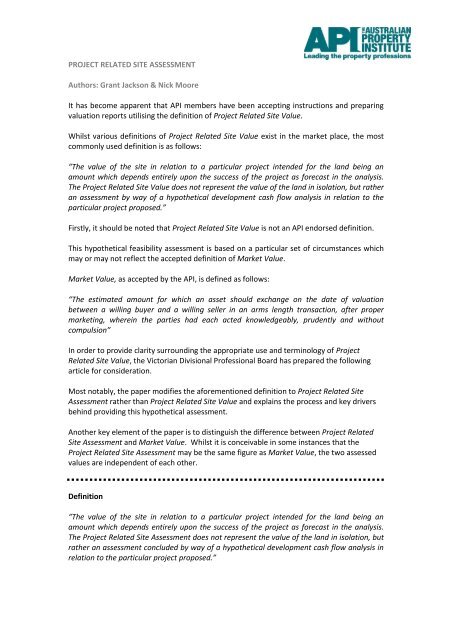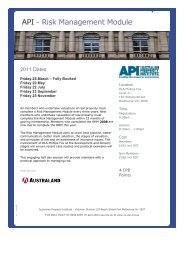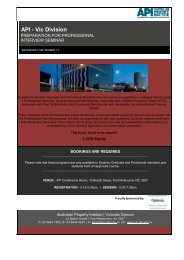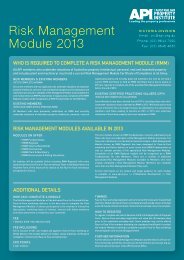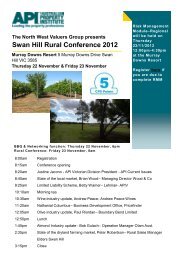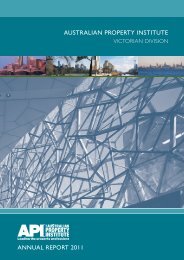PROJECT RELATED SITE VALUE - The Australian Property Institute
PROJECT RELATED SITE VALUE - The Australian Property Institute
PROJECT RELATED SITE VALUE - The Australian Property Institute
You also want an ePaper? Increase the reach of your titles
YUMPU automatically turns print PDFs into web optimized ePapers that Google loves.
<strong>PROJECT</strong> <strong>RELATED</strong> <strong>SITE</strong> ASSESSMENT<br />
Authors: Grant Jackson & Nick Moore<br />
It has become apparent that API members have been accepting instructions and preparing<br />
valuation reports utilising the definition of Project Related Site Value.<br />
Whilst various definitions of Project Related Site Value exist in the market place, the most<br />
commonly used definition is as follows:<br />
“<strong>The</strong> value of the site in relation to a particular project intended for the land being an<br />
amount which depends entirely upon the success of the project as forecast in the analysis.<br />
<strong>The</strong> Project Related Site Value does not represent the value of the land in isolation, but rather<br />
an assessment by way of a hypothetical development cash flow analysis in relation to the<br />
particular project proposed.”<br />
Firstly, it should be noted that Project Related Site Value is not an API endorsed definition.<br />
This hypothetical feasibility assessment is based on a particular set of circumstances which<br />
may or may not reflect the accepted definition of Market Value.<br />
Market Value, as accepted by the API, is defined as follows:<br />
“<strong>The</strong> estimated amount for which an asset should exchange on the date of valuation<br />
between a willing buyer and a willing seller in an arms length transaction, after proper<br />
marketing, wherein the parties had each acted knowledgeably, prudently and without<br />
compulsion”<br />
In order to provide clarity surrounding the appropriate use and terminology of Project<br />
Related Site Value, the Victorian Divisional Professional Board has prepared the following<br />
article for consideration.<br />
Most notably, the paper modifies the aforementioned definition to Project Related Site<br />
Assessment rather than Project Related Site Value and explains the process and key drivers<br />
behind providing this hypothetical assessment.<br />
Another key element of the paper is to distinguish the difference between Project Related<br />
Site Assessment and Market Value. Whilst it is conceivable in some instances that the<br />
Project Related Site Assessment may be the same figure as Market Value, the two assessed<br />
values are independent of each other.<br />
Definition<br />
“<strong>The</strong> value of the site in relation to a particular project intended for the land being an<br />
amount which depends entirely upon the success of the project as forecast in the analysis.<br />
<strong>The</strong> Project Related Site Assessment does not represent the value of the land in isolation, but<br />
rather an assessment concluded by way of a hypothetical development cash flow analysis in<br />
relation to the particular project proposed.”
FACTORS INFLUENCING THE <strong>VALUE</strong> OF LAND<br />
Preamble<br />
<strong>The</strong> value of land can change as the level of uncertainty and risk associated with the<br />
successful and profitable development of the land is either mitigated or eliminated in the<br />
development process.<br />
Land in its virgin or greenfield state is subject to all of the inherent risks associated with<br />
development of the site. As those risks are quantified, minimised or eliminated, the value of<br />
land may change.<br />
<strong>The</strong> value of land will always be dependant upon the prevailing market conditions and<br />
general economic factors.<br />
.<br />
<strong>The</strong> following list whilst not intending to be exhaustive highlights some of the key items<br />
which bring certainty and eliminate risk which in turn add value to land in relation to an<br />
intended project.<br />
Planning Risk<br />
Once a site has either been rezoned to a higher and more appropriate use or a planning<br />
permit has been issued for the most optimal use of a site, the value of the site can be<br />
enhanced. <strong>The</strong> level of enhancement (if any) in value will be dependent on market<br />
conditions, and be reflective of the certainty that planning risk for that particular project has<br />
been eliminated.<br />
Environmental Risk<br />
Once it has been established via expert consultants and both local and state authority<br />
approvals that a particular site is free of any environmental concerns either on the land or<br />
within the land, this has the impact of bringing greater certainty and confidence to the<br />
intended project for the site.<br />
Construction Risk<br />
On the assumption that the particular project represents the highest and best use of the<br />
land, once that project has been independently costed by a qualified Quantity Surveyor, or<br />
tendered and awarded to a reputable construction company, a higher degree of certainty is<br />
attached to the project intended for the site and the level of risk is mitigated.<br />
As the construction of the project proceeds through the development program in a timely<br />
and orderly manner and in accordance with budget, the level of construction risk may be<br />
gradually minimised.
Servicing Risk<br />
A particular site may require servicing to meet the needs of the intended project or an<br />
upgrade of existing services to be able to reap the potential and develop to the highest and<br />
best use of the site. Once it is established with the appropriate authorities that the available<br />
services are either able to be connected or the cost to connect those services is accurately<br />
established, this may mitigate the level of risk and uncertainty in providing services to the<br />
land.<br />
Leasing Risk<br />
In those projects where a component or all of the proposed development is for investment<br />
purposes where a tenant or multiple tenants are being sought for the development, the<br />
level of risk associated with attracting tenants is minimised with the signing of agreements<br />
to lease to occupy the development upon completion.<br />
<strong>The</strong> commitment of a major tenant or multiple tenants to a proposed project will bring<br />
increased certainty to the project in terms of market demand and acceptance together with<br />
establishing the level of return achievable from the proposed development.<br />
<strong>The</strong> securing of commitments to lease also brings certainty to the initial unknown lease<br />
terms and conditions anticipated for the development. <strong>The</strong> securing of future income upon<br />
completion of the development provides a higher degree of certainty and confidence in the<br />
viability and acceptance of the proposed project.<br />
Financing Risk<br />
Invariably most developments of land involve the procuring of finance to assist in the<br />
development process. Once suitable terms and conditions have been negotiated with a<br />
reputable financier the level of risk and uncertainty associated with a project may be<br />
substantially mitigated.<br />
Realisation Risk<br />
Whether the form of development of the land be for longer term investment purposes,<br />
immediate sale or a combination of both the ultimate realisation of the completed project is<br />
a critical factor in the viability of the development of the site. If a pre-commitment to sell the<br />
entire project or various components of the project either prior to or during construction is<br />
achieved, on reasonable market terms and conditions with a full deposit being paid, this<br />
brings a higher degree of certainty to the end realisation achievable for the project.<br />
Settlement Risk<br />
Even though projects may attract interest from purchasers via the way of presales either<br />
prior to or during construction, those contracts are still subject to formal settlement and<br />
payment of the balance of the purchase price. Once a project is completed in whole or in<br />
stages, those components of the development which are able to settle and full purchase<br />
monies received bring further certainty to the development of the site.
Profit & Risk<br />
Each Project Related Site Assessment will require an entrepreneurial market based margin<br />
for profit and risk which should reflect the risk associated with any such development.<br />
Preferred Valuation Methodology<br />
In considering the Project Related Site Assessment the preferred methodology to value is the<br />
hypothetical development or feasibility approach related to the specific project proposed for<br />
the site. <strong>The</strong> hypothetical development method is a long accepted approach to value which<br />
is undertaken by competent valuers on a daily basis for a range of asset classes and purposes<br />
of valuation for vacant land or sites suitable for development.<br />
<strong>The</strong> criticism often made of the hypothetical development approach is that it is dependant<br />
upon the accuracy and certainty of the variables assumed by the valuer in the overall<br />
development model. If each of those variables adopted by the valuer are able to quantified<br />
with a greater level of certainty, there is a far greater likelihood that the land value indicated<br />
from the hypothetical development approach will be more accurate, having regard to the<br />
project proposed.<br />
<strong>The</strong> direct comparison of the sale of vacant land to assess the land value of a specific project<br />
may not necessarily be an accurate and equitable means of comparison when a specific<br />
project is being considered. If a specific project for a site has been able to mitigate to a large<br />
extent a number of the uncertainties and variables associated with the potential successful<br />
development of the land, the value of that site may well be substantially different from the<br />
value of otherwise similar vacant sites without such benefit. Those sites may not be subject<br />
to a similar level of certainty in respect of their development potential.<br />
Importantly, valuers and users of valuation reports alike should be aware that these site<br />
specific value-add enhancements highlighted herein can diminish or disappear entirely<br />
within a short period. This can be due to a number of factors including, but not limited to, a<br />
change in the highest and best use of the site, depressed market conditions or reduction in<br />
demand for the project upon completion.<br />
Furthermore, it is important to recognise and have an appreciation of the ability to transfer<br />
those identified enhancements. For example, a planning permit or pre-sales might be<br />
reflected in the price paid in the open market but a developer’s ability and capacity to sell<br />
down a project may vary significantly and reflect an intangible component which does not<br />
necessarily run with the land in an open market transaction but may instead be addressed in<br />
a Project Related Site Assessment.<br />
Valuation Instructions<br />
<strong>The</strong> Project Related Site Assessment is based upon a particular project proposed for the site<br />
which as outlined above may be at a relatively advanced stage of development with the<br />
satisfying or elimination of the various risks associated with the development of land.<br />
This terminology varies from the definition of Site Value as outlined within the Valuation of<br />
Land Act 1960 which is as follows:
“site value” of the land, means the sum which the land, if it were held for an estate in fee<br />
simple unencumbered by any lease, mortgage or other charge, might in ordinary<br />
circumstances be expected to realise at the time of valuation it offered for sale on such<br />
reasonable terms and conditions as a genuine seller might be expected to require, and<br />
assuming that the improvements (if any) have not been made”;<br />
Valuation Instructions (continued)<br />
<strong>The</strong> <strong>Australian</strong> <strong>Property</strong> <strong>Institute</strong> has also published a definition of market value which is<br />
based broadly on the principles as set out Spencer v the Commonwealth [1907] 5 CLR and is<br />
as follows.<br />
“Market Value is the estimated amount for which an asset should exchange on the date of<br />
valuation between a willing buyer and a willing seller in an arms length transaction, after<br />
proper marketing, wherein the parties had each acted knowledgeably, prudently and without<br />
compulsion.”<br />
<strong>The</strong> Project Related Site Assessment definition relates to a specific project intended for the<br />
site and is therefore a specific and narrow definition for a particular project and is not to be<br />
misconstrued as a more generic and general definition of site value within the Valuation of<br />
Land Act or market value as prescribed by the <strong>Australian</strong> <strong>Property</strong> <strong>Institute</strong>.<br />
Disclaimers and Limiting Conditions<br />
It is strongly recommended that any valuer providing a Project Related Site Assessment<br />
should firstly have clearly established a proper definition. <strong>The</strong> valuer should then verify with<br />
formal documentation those matters assumed as part of the process to either limit or<br />
eliminate the risk associated with a specific project are valid.<br />
In this regard documentation could include but is not limited to a copy of the planning<br />
permit, a copy of a signed transferable construction contract binding on the parties specific<br />
to the proposed project, any agreements to lease, offers to lease, or other indicators of<br />
tenant demand to assist in establishing rental parameters and demand for the project,<br />
signed copies of presale contracts for the entire or proposed components of the<br />
development including documentation of deposits paid, confirmation of appropriate expert<br />
reports in relation to environmental issues, heritage issues and servicing of the land and<br />
confirmation of the appropriate funding terms and conditions from a reputable financier.<br />
If documentation has not been provided or has not been sighted then the appropriate<br />
qualifying and limiting conditions surrounding the assumptions made should be clearly<br />
outlined. If the documentation has been provided that documentation should be specifically<br />
referred to if it is relied upon or not relied upon as part of the hypothetical development<br />
approach to value. Documentation alone does not relieve the valuer of the obligation to<br />
undertake their own independent enquiries to satisfy themselves of the market conditions<br />
for the particular project proposed for the site.<br />
Market Value<br />
It is recommended that if a valuer is requested to provide a Project Related Site Assessment<br />
of a parcel of land having regard to a particular project, the valuer also provide the Market
Value of the land in accordance with the endorsed API definition of market value. This<br />
assessment should be underpinned by comparable contemporaneous sales and will highlight<br />
the variation (if any) between the two approaches to ensure the reader of the report is fully<br />
aware of the difference between a Project Related Site Assessment and the Market Value of<br />
the land.


